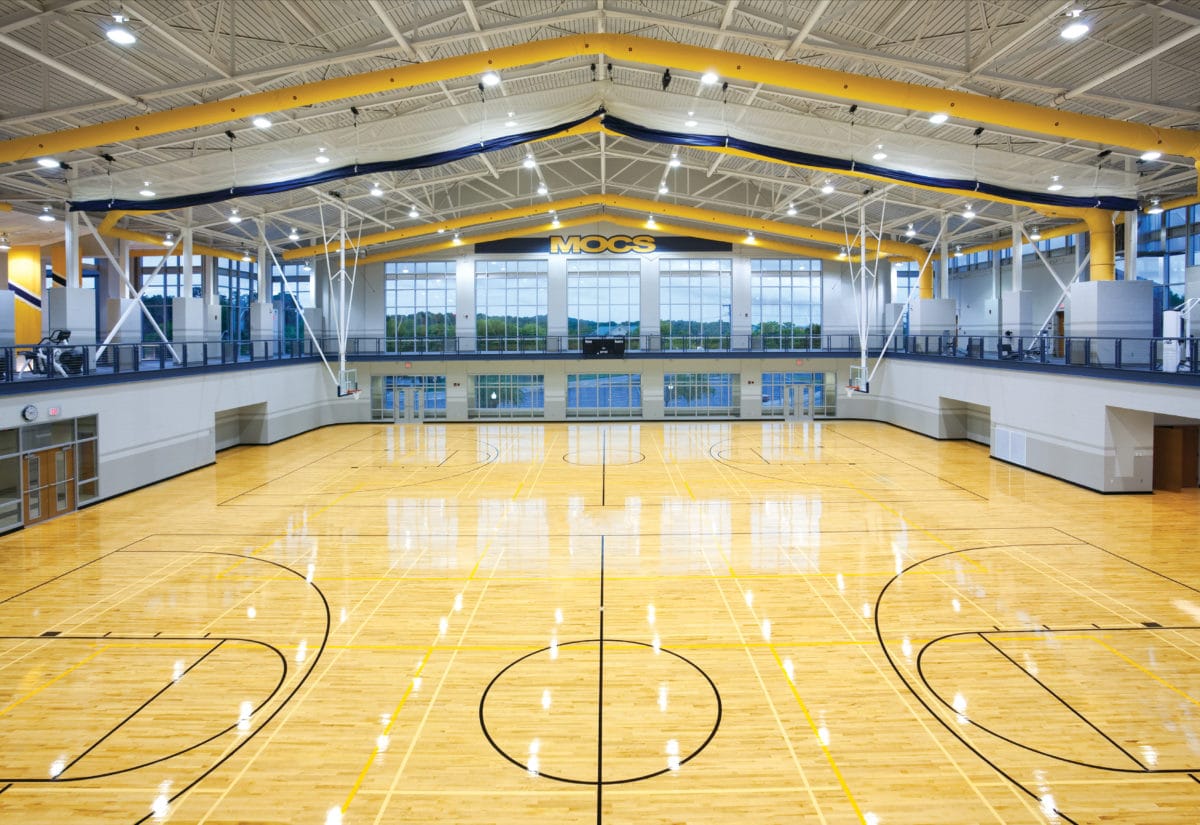Story at a glance:
- 4,000 solar panels helped the Mercedes Benz Stadium in Atlanta achieve LEED Platinum certification.
- Flooring is crucial for athletes when it comes to absorbing shock and keeping people safe.
- HVLS fans keep air moving, contributing to better indoor air quality in athletic facilities.
A lot of sweat, sometimes blood, and, on a really bad day, tears. But one thing you shouldn’t have to worry about at the gym or any sustainable sports facility is other toxins.
Indoor air quality and durable flooring that doesn’t kill your legs and feet are just some of the design considerations architects take seriously when designing their best projects.
Here are some of the key ingredients top architects we’ve talked to say they incorporate when setting out to design a memorable sustainable sports facility.
Solar Panels
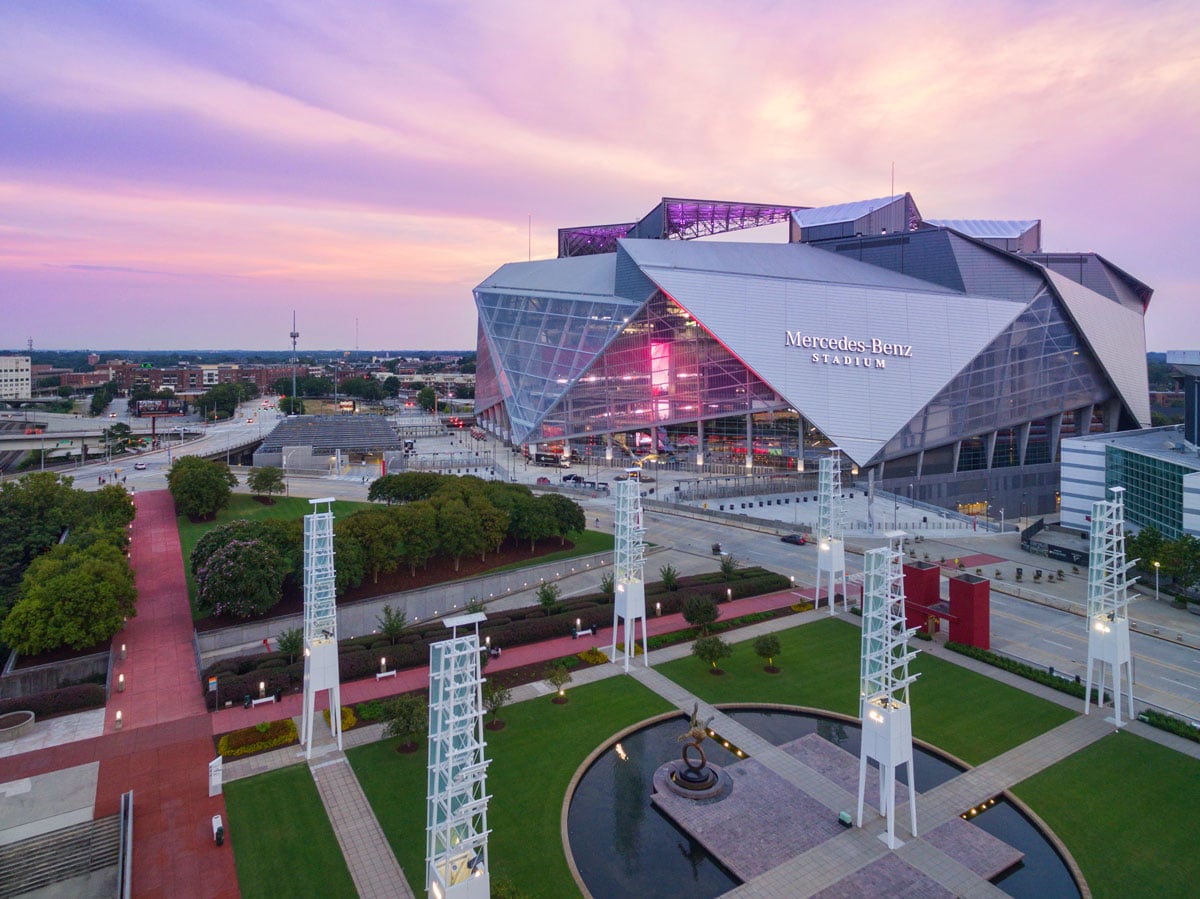
The Mercedes-Benz Stadium in Atlanta is the first LEED Platinum professional sports venue in the world. Photo courtesy of AMBSE
The Mercedes Benz Stadium in Atlanta is a standout example of a sustainable sports facility. The 2 million-square-foot, $1.5 billion project was designed by HOK, who worked with BuroHappold Engineering and Hoberman Associates to complete the stadium in July 2017.
Perhaps the most incredible element of this LEED Platinum project is its commitment to solar energy, with 4,000 solar panels placed not on the rooftop but at eye level on ticket entryways and parking lot canopies.
The panels generate enough energy to power nine Atlanta Falcons games or 13 United matches.
But you don’t have to be a large project to use the sun to your benefit. Another, much smaller project in Georgia, this one designed by Lord Aeck Sargent, also inspires with its use of solar panels. The Georgia Sports Park Pavilion project is powered by the sun through 70 flat 340-watt photovoltaic solar panels on the south sloping roof. The array provides more than enough energy to power the building during daylight hours.
The PV panels, installed by Velo Solar, provide the power needed to operate the building year-round.
According to Rick Bizot, who’s worked across project types for decades at the architecture firm, the energy from the sun provides more than twice that needed to run the building, resulting in the building’s energy performance being net-positive. The excess energy is returned to the East Point Power grid. Further, peak demand for energy comes at the same time the PV system is producing its best response to energy needs. The good news is, in looking to the future, the solar power systems do not require a lot of maintenance, usually only requiring cleaning a couple of times a year.
LED Lighting

Energy Focus’ 200D and 300D Series LED Tubes come in frosted or clear. The 200D Series LED’s use 15-18 watts per lamp as opposed to the 32-36 watts per lamp used by fluorescents. Photo courtesy of Energy Focus
The design of Mercedes-Benz Stadium also features an impressive halo board—at 350 tons and 58 feet high by 1,100 feet around, the stadium’s impressively massive video screen is more than 63,000 square feet of LED lighting. In fact, all of the venue’s lighting is LED, which lasts 10 times longer than standard lighting and reduces energy usage by as much as 60%.
“Everything about this building was designed very intentionally to be innovative and groundbreaking from an environmental standpoint,” said Scott Jenkins, stadium general manager and chairman of the Green Sports Alliance, in a previous interview with gb&d.
Natural Light
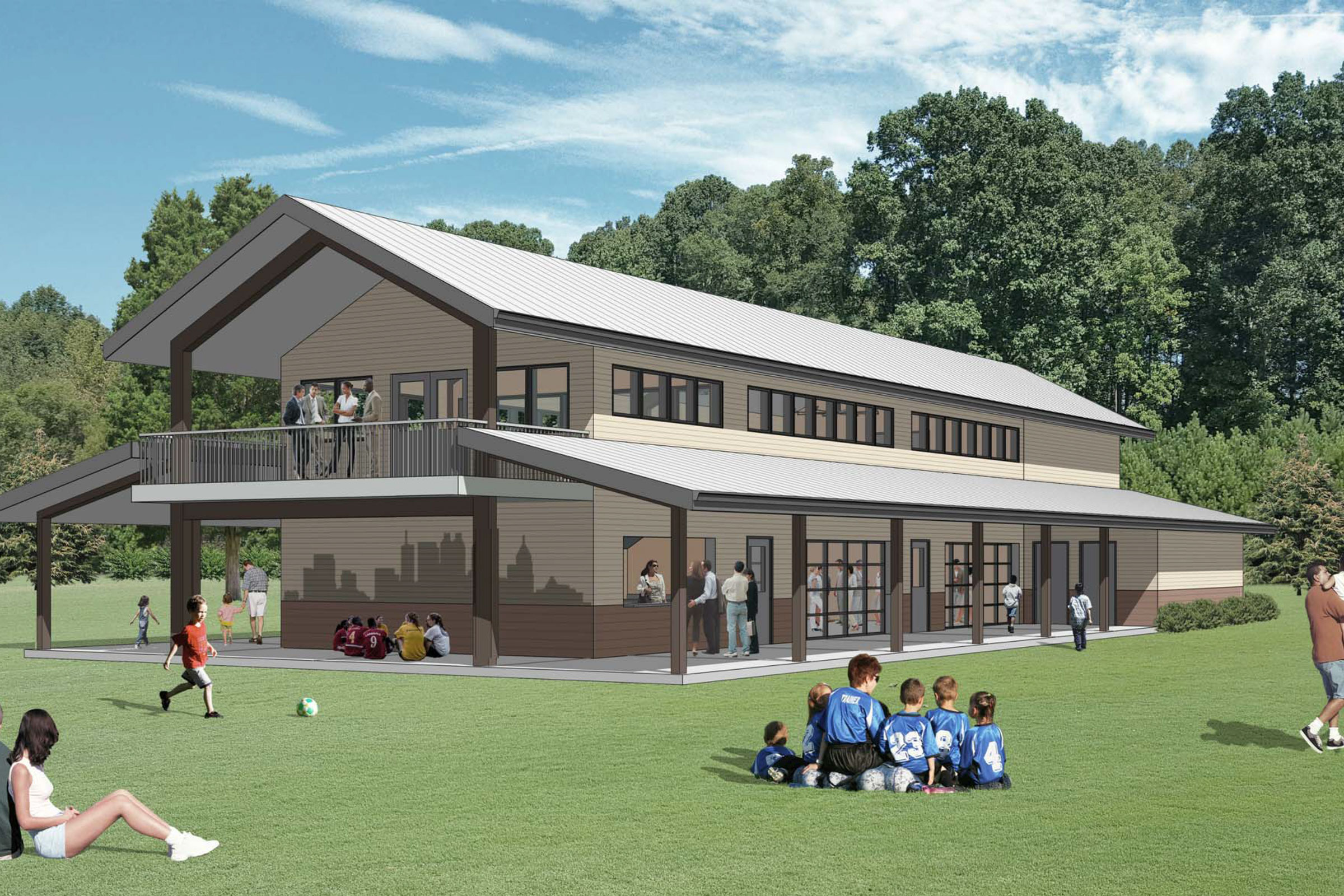
Rendering of new Georgia Sports Park Pavilion, opened in November 2020. courtesy of Lord Aeck Sargent
At the Georgia Sports Park pavilion, the design team took a strategy that relied heavily on natural light, supplemented by smart LED lighting.
Designed by Barnett Consulting Engineers and Ardd + Winter, the light level in the classroom was designed using less than 700 watts of artificial light. To optimize the efficacy of the lighting in the space, and after specifying high-performance light sources, lighting controls are used to further reduce energy use.
During the clear daylight hours with all the lights on, the incident light can be as bright as 80 foot candles, however, when the foot candles increase beyond 40 foot candles, the light level photo sensors reduce the light level to keep the classroom between 40 and 50 foot candles. The remainder of the spaces also have the appropriate amount of LED light. The pavilion also uses occupancy sensors which turn lights on or off in response to the presence of occupants.
HVLS Fans

Photo courtesy of Entrematic
Keeping the air moving is critical in sports facilities like gyms.
The often colorful, five-blade Entrematic HVLS fans can be spotted at many gyms, rock climbing facilities, fitness centers, and more if you just look up.
Entrematic’s downturned wingtip promotes airflow efficiency, funneling turbulent air away. “Early helicopter blades had a flat end, but they found that as the blade moves it lifts, so the tips fly up,” Richard Hoofard, director of engineering at Entrematic, told gb&d. Entrematic’s blade was designed to be relatively stiff, and they wanted the blade to stay as horizontal as possible without flexing throughout operation. They added downward winglets to reduce the wingtip vortice, allowing the blades to keep moving air down.
Using Entrematic Fans can create a perceived temperature change in a building of about 4 to 7 degrees, which allows for a 3 to 5 degree thermostat adjustment—in both summer and winter—with about 3% of energy savings per degree. Taken in total, these fans can help to save as much as 15% off a typical commercial space’s energy bill.
Entrematic’s C-Class commercial fans are an especially good fit for gyms, like the 66,000-square-foot Telos Fitness Center in Dallas, as the fans circulate large amounts of air with ease.
“Everyone is in there sweating. It would get pretty stuffy without the fans,” Mike Pope, director of facilities for the four-story luxury workout facility, previously told our staff.
Two 14-foot fans overlook Telos’s two-story area with an open-air running track on top. Considering the center is in a 30-year-old building with equally old air conditioners, Pope says it needed a little help circulating air—especially on 100-degree Texas days.
“From where the fans are to where the floor of the coliseum is is about 40 feet,” he says. A small fan couldn’t push enough air from the vents to the workout room below. Not to mention Telos has glass windows surrounding the track, drawing even more heat in. “That was one of the biggest needs—to find something that was able to push enough cool air down on top of the workout room,” he says.
Companies like Big Ass Fans have helped some facilities even reach net zero, with well-designed fan systems that can eliminate the need altogether for a compressurized (traditional) cooling system. One such example is the La Escuelita Education Center in Oakland, California. In the area’s mild climate, the school relies on building mass, natural ventilation, night flush cooling, and HVLS fans from Big Ass Fans to achieve the net-zero goal; it’s just one example of how collaboration with the project team results in an efficient system.
Rubber Flooring
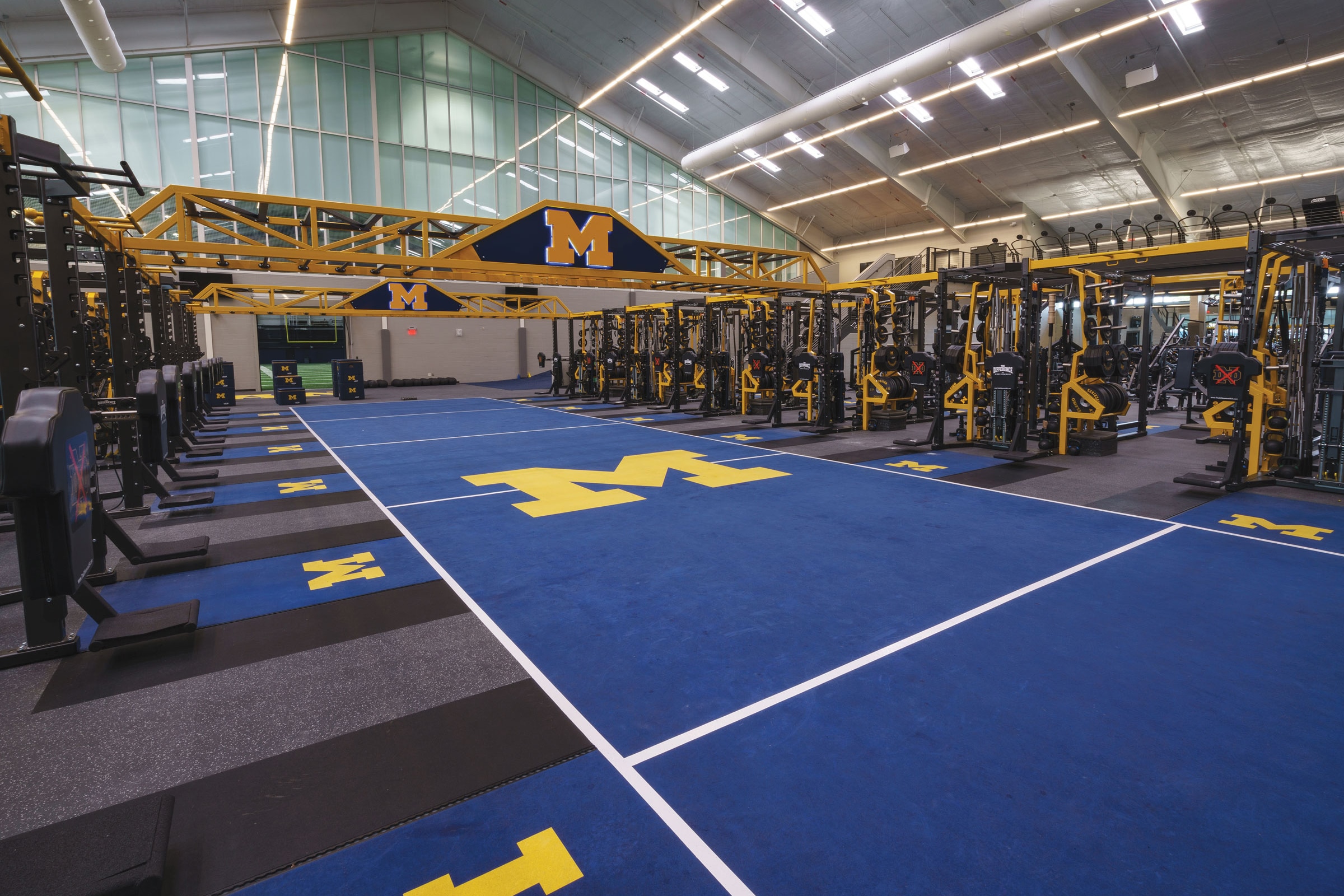
This 36,000-square-foot weight room is a feature in the University of Michigan’s 78,000-square-foot Oosterbaan Field House. Photo courtesy of REGUPOL
But building a truly sustainable sports facility means designing with green features in mind from the floor up.
Rubber gym flooring like what you might find at the Anaheim Ducks Training Facility at Five Point Arena in Irvine, California or University of Michigan’s Oosterbaan Field House is both durable and aesthetically pleasing, as projects like these worked with REGUPOL.
A standard AktivPro Roll system from REGUPOL is 24 millimeters thick and made up of a customizable underlayment and a dense wear layer surface. You can choose from three underlayments—Plyo, Fitness, and Impact—in varying density and thickness. Each underlayment is engineered to absorb maximum shock on impact, diminish barbell bounce, and ease joint stress while simultaneously delivering ideal energy return levels for safer training and drastically boosted performance.
In Wisconsin, Action Floors also incorporates recycled-content elements in its systems and uses natural rubber resilient pads made from an environmentally friendly process where rubber tree sap is collected and then vulcanized to deliver superior shock absorption. The sustainably conscious flooring company also utilizes low-energy production measures and recycles its wood waste to provide steam for milling, reducing its need for fossil fuels.
Wood Flooring

Action Floors continues to develop and engineer outstanding athletic floor systems, like this one at UW-River Falls. Photo by Kathy M. Helgeson
The Action Floors President previously told gb&d that its maple flooring is what makes it truly stand out.
In the US, maple is by far the preferred floor surface for basketball, volleyball, racquetball, squash, aerobic and dance studios, and even performance stages. And maple flooring is—and always has been—the core of Action Floors’ business.
“Maple is the only hardwood product we mill—we specialize in maple flooring,” Tom Abendroth told us.
He says the wood’s light color makes it the leading choice, lending itself to superb game line and graphics visibility. The cell structure of hard maple is also ideal, allowing for the flexibility a flooring system needs to achieve high-performance shock absorption and bounce.
Shock Pad

NXTPlay performance shock pad installation at Georgia Tech’s Bobby Dodd Field in Atlanta. Photo courtesy of Shaw Sports Turf
Of course, beyond comfort and sustainability there’s also playability. How do you design a sustainable sports facility athletes actually can play on?
Shaw Sports Turf introduced NXTPlay Performance Shock Pad with this question in mind, aiming to provide a super performance surface that also just happens to be made from reclaimed and recycled turf fields.
With the introduction of NXTPlay shock pad, Shaw offers a one-stop source for every component of an artificial turf system, from the pad up. This system approach gives the athlete freedom to focus on their craft, not the playing surface.
With strong performance in HIC and gmax testing, as well as assessment of rotational traction, force reduction, energy rebound and other metrics, NXTPlay shock pad provides a head-to-toe approach to playability and safety. The shock pad helps create a firm, natural feel underfoot, as well as natural ball-to-surface and player-surface interaction.
Stormwater Management
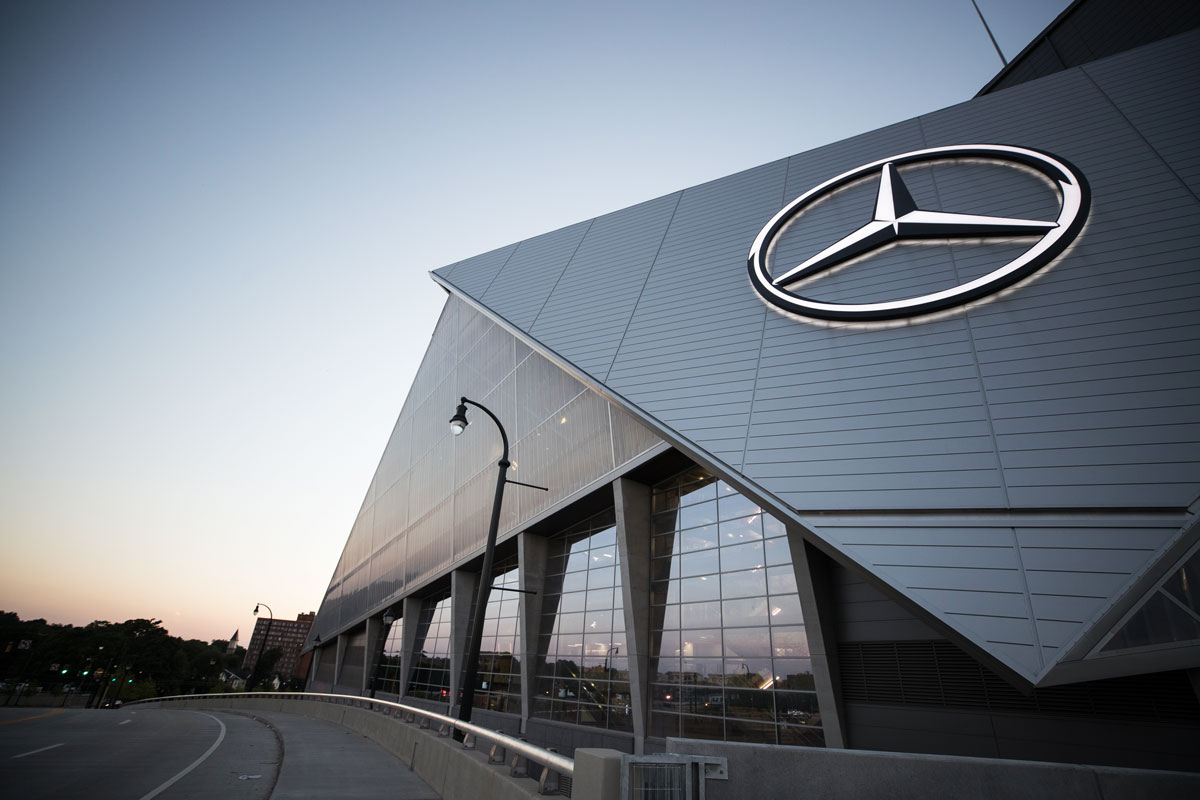
Mercedes Benz Stadium, in Atlanta, designed by HOK. Photo courtesy of AMBSE
Good green design of a sustainable sports facility doesn’t stop inside.
The aforementioned Mercedes Benz Stadium in Atlanta, designed by HOK, took its sustainable design principles outside and underground, too, with an advanced stormwater management program that includes an onsite 2.1 million gallon stormwater vault, bioswales, and a 680,000-gallon cistern for collecting and reusing rainwater for a cooling tower and irrigation.
This incredible system combined with water-efficient fixtures resulted in a 47% reduction in domestic water use.

